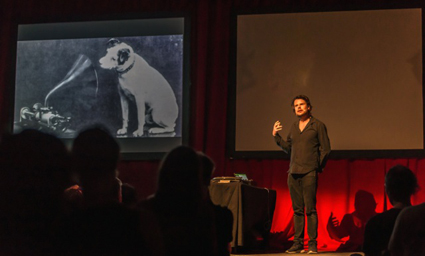The performance lecture: the dead & the dead-end
John Bailey, Trilogies

Erik Bünger, Performance Lecture
photo Bruce Davis
Erik Bünger, Performance Lecture
The lecture performance has had something of a renaissance in the era of live art. Once a staple of performance art in the 1960s and 70s, it offered a novel way of reconsidering the interstices of creation and pedagogy, and the power dynamics that define the significance of art practice beyond the moment of individual reception.
How does that translate into the age of TEDx talks, in which an endless succession of experts deliver animated lectures that claim the solution to all of the world’s ills are contained in a 15-minute walk through their particular area of research? A pair of lecture performances were presented as part of the recent Trilogies exhibition in Melbourne in January, and left me wondering what role the mode itself can play today.
Soda_Jerk is the Sydney-raised, New York-based duo of Dominique and Dan Angeloro, whose lecture The Carousel is an assemblage of Hollywood scenes spliced together by commentary that produces a dialogue between the disparate clips. Many of the films chosen come from the shallow end of Hollywood’s pool—goth-action flick The Crow, Bruce Lee knockoffs, roundly derided vampire trash Queen of the Damned and even Ed Wood’s notorious Plan 9 From Outer Space.
The thread that binds the generous collection is that of stars who died during shooting or before the film’s release. It’s a literal rendering of the notion of hauntology, in which the spectre of the past exists within the present, and which often traces its lineage to Jacques Derrida (who also appears here).
Derrida’s argument is that cinema is always already haunted. Even actors who are still alive today will one day be dead, yet forever reanimated on the ghostly screen. Soda_Jerk argue that the ‘ghost box’ that Thomas Edison purportedly attempted to create in his later years has been hiding in plain sight all along as the cinematograph. Their lecture asks its audiences to put the theory to the test themselves, serving up scene after scene in which dead performers continue to enact the artificial rituals of Hollywood, even in some cases brought back from the grave by CGI technology.
Erik Bünger’s The Girl Who Never Was is another exercise in hauntology, but one that centres more on the phantoms that are words. It begins with the spinning of a turntable, through which Bünger conjures the oldest recorded human voice, that of a little girl humming Au Clair de la Lune. Slowed down, however, as it was discovered in 2009, it becomes apparent that the voice is that of a grown man, and the story of the little girl that had accompanied the recording is revealed to have an absence at its centre.
Bünger’s lecture now travels into the future as envisioned by one past, that of Kubrick’s 2001: A Space Odyssey. In France the HAL’s dying words were translated as the same song, Au Clair de la Lune, slowing down as the computer’s systems are dismantled. Yet a computer doesn’t slow down when it is switched off, Bünger notes. At HAL’s heart must be another, older technology, that of the haunted phonograph. From these intriguing connections Bünger’s lecture begins to produce a gyre that expands wider and more wildly than most conventional lectures would be allowed. From computing pioneer Alan Turing’s tragic suicide by poisoned apple we leap to the ubiquitous logo of the Apple corporation with its iconic single bite and from there it’s back to the Old Testament, where the original sin is not Eve’s own bite but Adam’s crime of listening to her words. The erasure of female speech takes us to Adorno’s claim that audio technology rendered women’s voices “shrill” and unpleasant, and that only men should be recorded, and this segues into scenes from Werner Herzog’s Fitzcarraldo in which the operas of Caruso are projected into the Amazonian jungles, the male voice utilised as a weapon of colonialism.
Both of these lecture performances use montage to raise provocative and compelling questions which draw on theories enjoying some currency in academia and cultural theory, but their arguments are loose, associative, laughably unacquainted with the scientific method but not interested in proving any hypotheses beyond reasonable doubt. Bünger’s lecture, particularly, seems close to the paranoid method of critical thinking, in which everything can in some way be traced back to the argument being made. What that argument is, exactly, is never entirely clear, and so there is a magnetic absence at the heart of his performance just as uncanny as the ghostly child of its title. If the TEDx talk’s promise of an accessible resolution to existential ailments is both its appeal and its disappointment, these lecture performances make more apparent the emptiness we try to conceal whenever we pull one up on our screen. Those lecturers too will one day be dead.
TRILOGIES, Erik Bünger, Soda_Jerk, Willoh S Weiland/Aphids & OtherFilm, curator Will Foster, The Substation, Newport. 23 Jan-15 March
RealTime issue #125 Feb-March 2015 pg. 36






